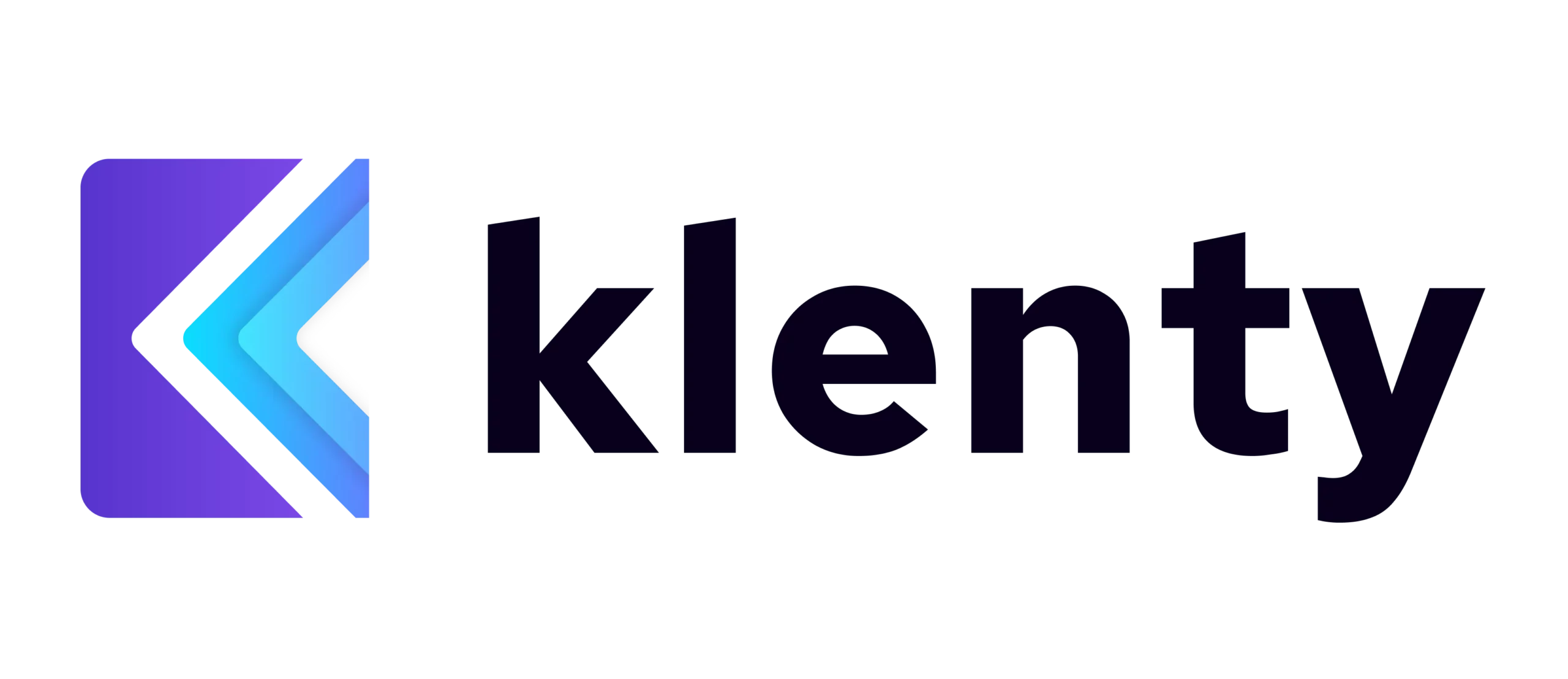In the fast-paced world of B2B sales, there are 2 major ways to score big: inbound and outbound.
Inbound is all about attracting potential buyers toward you, while outbound lets you go on a wild adventure to find new buyers. With evolving buyer behavior and a rise in digital resources, many B2B sales teams are now shifting focus from outbound to inbound sales.
But that doesn’t mean that outbound sales is no longer a thing.
Believe it or not, your prospects actually want to hear from you, especially in the early stages of the buying process. Research shows a whopping 82% of buyers willingly accept meetings with sellers who make an effort to reach out to them.
So, what exactly is outbound sales? And how does it differ from its inbound counterpart? We'll spill the beans here, and equip you with some killer outbound sales tips and tools to up your sales game and charm your prospects. So, buckle up as we dive into the world of outbound sales.
What Is Outbound Sales?
In a nutshell, outbound sales is all about making the first move and reaching out to your potential customers. Instead of waiting for prospects to find you, you take charge and get in touch with them through methods like cold calling or cold emailing. The aim is to connect with potential clients and get them interested in your product.
When you're cold calling, you're basically calling prospects out of the blue. You start by introducing yourself and telling them why you're calling, then you present your product or service and try to have a fruitful conversation to convince them to become potential customers.
Cold emailing has the same objective. But instead of sending a generic email, you make them more direct and personal by crafting messages that grab your prospect's attention and encourage them to take action.
How Is Outbound Sales Different From Inbound Sales?
While outbound sales is proactively reaching out to prospects, inbound sales draws them towards you.
Inbound sales relies on providing valuable information and resources to prospects to draw them in and nurture them throughout their buyer's journey.
How? Through effective lead generation strategies like search engine optimization (SEO), content marketing, email marketing, and social media marketing. These tactics draw in potential customers to your website, helping them dig deeper into your brand and what you have to offer.
Once they engage with the content or show interest, sales teams nurture them through personalized communication and customized solutions.
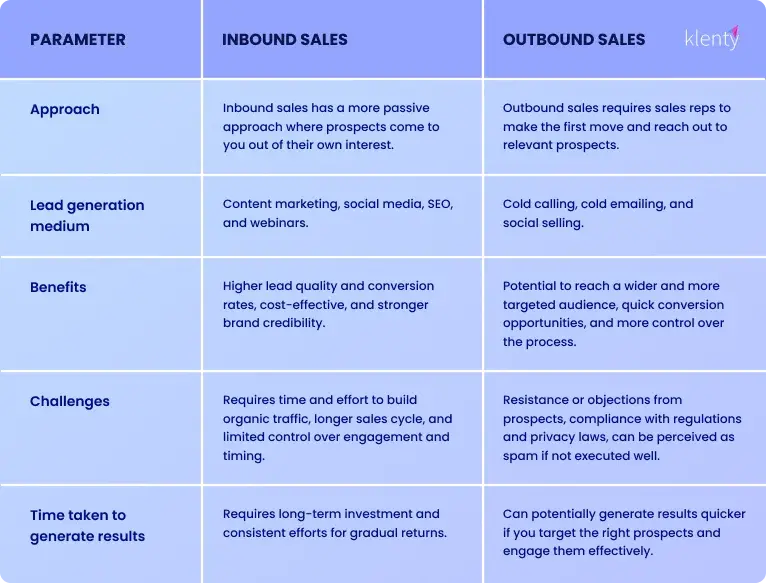
Advantages of Outbound Sales
Now that the difference between inbound and outbound is laid out, now comes the question: Which one’s better for your sales team?
As we saw above, the inbound strategy takes a more passive approach to seeking new leads and requires long-term investment, leading to longer and uncertain sales cycles.
This is where outbound sales can swoop in and save the day.
In outbound sales, you actively pursue targeted prospects. Doing this opens doors to new opportunities and expands your customer base, leading to a boost in your sales and revenue generation.
Let's dive into the key benefits of outbound sales and how they can ramp up your sales game.
1. Lets You Target Your Audience Better
With outbound sales, you can identify and focus your efforts on prospects and businesses that are most likely to benefit from your product. In other words, you can create an Ideal Customer Profile (ICP) based on factors like industry, revenue, goals, and budget, and reach out to them to boost your chances of success (more on this later).
What's more? With a better understanding of who you're reaching out to, you can personalize your messages, emails, and calls to really hit home with their preferences and pain points. This helps you create a stronger connection with your prospects, increasing conversion rates.
"Make your prospect feel like you’re living in their shoes. When you include names of people on their team, the messaging becomes real. It makes a massive impact on your outbound sales success," says Florin Tatulea, Barley's sales director.
2. Quicker Response From Buyers
Outbound sales allows you to connect with prospects instantly. Unlike waiting for inbound leads to trickle in, it allows you to take charge and directly reach out to potential buyers. And when you initiate contact, you can present your value proposition, address their pain points, and tell them exactly how your product is the best solution for them.
This eliminates the time spent on preparation and nurturing leads, leading to quicker responses and accelerating the sales cycle.
3. Predictable Lead Generation
With outbound sales, your sales team will have more control over your lead generation process. Instead of crossing your fingers and hoping for clients to magically show up, you can effectively create a pipeline of potential customers and have a reliable stream of leads.
This makes lead generation more predictable, as the more prospects you reach out to, the greater your chances of booking meetings. It also allows you to plan your sales activities and allocate resources efficiently to drive sales growth.
4. Facilitates Rapport Building Better
87% of B2B buyers expect reps to act as trusted advisors. With outbound sales, you can deliver on this expectation better than with inbound sales. How? By interacting with prospects directly right from the first sales touch, which is not the case in inbound.
Direct interaction builds rapport better as it helps you in empathizing with their specific needs and pain points. This enables you to customize your pitches and establish genuine connections with prospects, which can position you as a trusted advisor to buyers.
5. Allows Automation of Processes
When running outbound sales campaigns, you can streamline and automate a big chunk of the repetitive tasks. In fact, high-performing sales companies are twice as likely to have automated sales processes compared to underperforming companies.
With automation tools, you can easily track prospecting activities, set up follow-up reminders, send personalized emails, and even make automated calls. This frees up your time, allowing you to focus on high-value activities, like building relationships and closing deals.
5 Steps of the Outbound Sales Process
A successful outbound sales strategy needs a systematic and efficient approach—from fixing your target audience to closing a deal. To help you get started, we’ve curated the 5 major steps to create an effective outbound sales strategy:
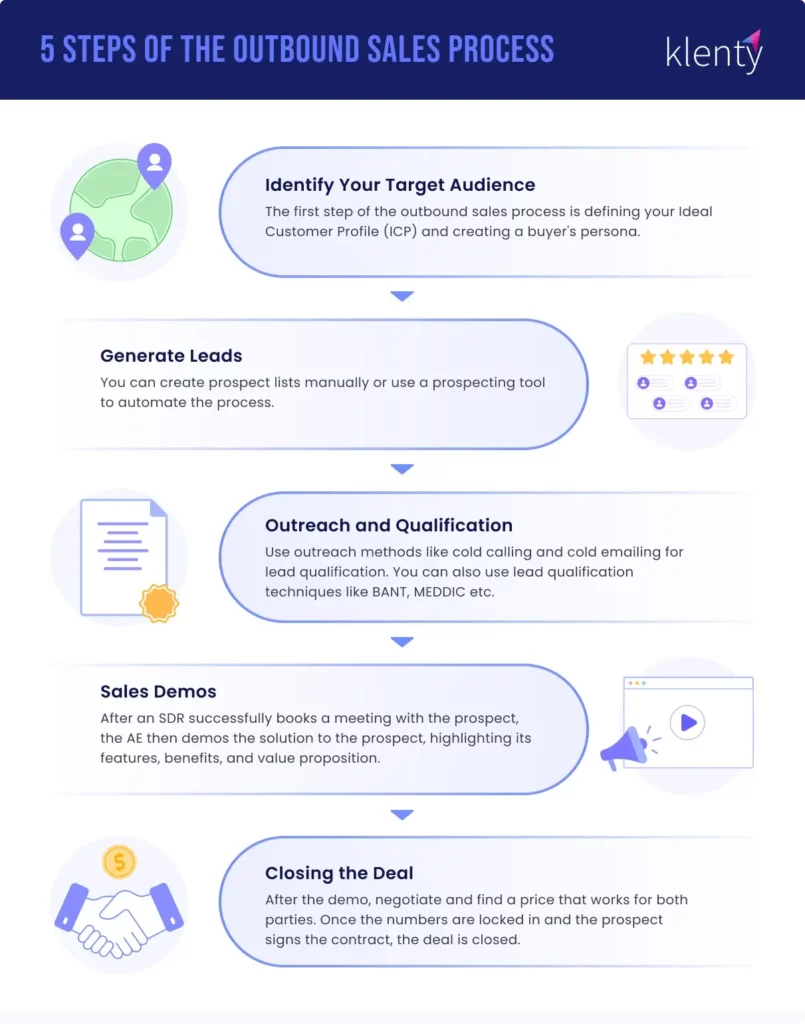
1. Identify Your Target Audience
The first step of the outbound sales process is determining who you will be selling to. This involves defining your Ideal Customer Profile (ICP) and creating a buyer's persona. An ICP describes the type of business that is most likely to benefit from your product. It goes beyond basic demographics and includes factors like industry, company size, business goals, pain points, and budget.
On the other hand, a buyer persona is a fictional representation of the key decision-maker of your ICP companies. It is based on details, such as their goals, job title, challenges, buying habits, and preferences.
Here's how you can create your ICP and buyer persona:
ICP:
- Look at your existing customers and evaluate them on parameters like success potential, average deal size, customer lifetime value, etc.
- Based on your findings, create a list of your top 10 existing customers and identify similar attributes between them.
- Use these attributes to define your Ideal Customer Profile.
Buyer Persona
- Once you've created your ICP, identify commonalities between the decision-makers of your top customers.
- Gather information like their demographics, job role, seniority, goals, and pain points.
- Use common attributes to create a fictional representation of your target customer.
- If there are more than one decision-maker, you need to create different buyer personals for all.
2. Generate Leads
A lead is someone who could be a good fit for your product. Once you've figured out which potential customers you want to reach out to, it's time to gather their details and contact information to assemble your pipeline.
There are a couple of ways you can do this. You can do it the old-fashioned way and manually create a list using tools like LinkedIn, social media platforms, or web directories. Or, if you want to make things easier, you can use a prospecting tool to automate the process. And if you're not keen on doing it yourself, you can even hire a lead gen agency to find the right prospects.
3. Outreach and Qualification
Once your pipeline is ready, the next step is determining qualified leads. These prospects meet all predefined criteria and have higher chances of converting into customers. But how do you qualify these leads?
Most outbound sales reps use cold calling and emailing for lead qualification. This helps them introduce their product, gauge the prospect's interest, and gather relevant information to qualify them as viable leads.
You can also use lead qualification frameworks like:
- Budget, Authority, Need, and Timing (BANT): It focuses on evaluating a prospect's financial capacity, decision-making authority, pain points, and the timeline for making a purchase decision.
- Metrics, Economic Buyer, Decision Criteria, Decision Process, Identify pain, and Champion (MEDDIC): It helps sales reps qualify leads based on factors like measurable metrics, the presence of an economic buyer with purchasing authority, their decision-making criteria, their pain points, and an internal champion who supports the purchase decision.
- Authority, Need, Urgency, and Money (ANUM): This is similar to BANT, but with an emphasis on authority. ANUM helps determine if the lead has decision-making authority, a genuine need for the product, a sense of urgency to address their needs, and the financial resources to make a purchase.
4. Sales Demos
After an SDR qualifies a lead and successfully books a meeting with them, the next step is to transfer the prospect to the account executive (AE). The AE then demos the product or service to the prospect, highlighting its features, benefits, and value proposition.
During the demo, the AE also addresses the prospect's pain points, explaining how the solution can effectively solve their challenges.
5. Closing the Deal
This is the moment you've been working towards, where all your efforts and strategies result in sealing the deal with your prospects. After nailing a killer demo, it's time to negotiate and find a price that works for both parties. Once the numbers are locked in, and the prospect signs the contract, the deal is closed.
Now that you know the different steps involved in the outbound sales process, next comes the question: How to actually reach out to your prospects?
Outbound Sales Techniques To Increase Revenue
Most sales professionals swear by 3 effective outbound sales techniques to amplify conversions and boost revenue:
Cold Calling
Cold calling is one of the most effective outbound sales strategies, where a sales rep calls potential customers to pitch their products. Before placing the call, they research the prospect, create a personalized sales pitch, and perfect their opener to maximize the chances of a positive response. To nail a cold call, you must have a persuasive communication style, know your product inside out, and be able to quickly build rapport with the prospect.
Cold Emailing
Cold emailing is about creating thoughtful, personalized communications that show your understanding of the recipient's pain points and provide meaningful solutions. You must find the perfect blend of being concise yet informative while highlighting the value you bring and sparking curiosity to persuade them to take action.
Social Selling
Social selling is the art of leveraging social media platforms to collect with prospects, build relationships, and ultimately drive sales. It allows you to go beyond old-school sales tactics and harness the power of social networks to up your sales game. Sales professionals who use social selling are 50% more likely to reach or exceed their quotas. You can use platforms like LinkedIn or Twitter to engage with a wide audience and build brand awareness.
5 Outbound Sales Strategies to Close More Deals
Outbound sales is effective, but it does not belittle the challenges sales reps face. Dealing with client rejections and having super high targets can make closing deals feel like climbing a mountain. But with these 5 killer tips for outbound sales, you can strengthen your pitch and close more deals quickly:
1. Automate and Scale Your Processes With the Right Tools
The best outbound sales software can help you boost efficiency and productivity while reaching a larger audience. They help you save time and effort by eliminating all boring manual tasks such as data entry, follow-ups, and scheduling. Plus, with outbound sales software, you can keep your brand messaging consistent, keep track of client interactions, and even use analytics to see how effective your outreach is.
Depending on your problem areas, you can choose from an array of tools. Here are the top 5 types of outbound sales automation software used by companies:
- Sales reporting/analytics
- Customer relationship management (CRM) system
- Account and contact management
- Mobile sales app(s) for employees
- Sales forecasting tools
2. Engage Prospects on Multiple Channels
Don't be afraid to go beyond just phone calls and emails and reach out to your prospects through other communication channels. It not only gives you more flexibility to reach them where they are most receptive but also increases the likelihood of capturing their attention.
Research shows 44% of B2B buyers do not wish to do business with companies that don't use their preferred channels for communication.
Nanditha Menon, a top-performing rep from G2, leverages LinkedIn to maximize chances of booking meetings. as her connects with prospects on LinkedIn and posts at least once a week to stay on top of their feed. This helps remind them to reply to her emails or LinkedIn messages. "I had a prospect who saw a LinkedIn post of mine, emailed me, and then we got a meeting," she recalls.
3. Send Personalized Emails and Time Them Well
Your prospect's inboxes are flooded with generic and impersonal emails trying to sell them the next best thing. So how do you stand out?
Personalization is what differentiates a cold email from junk mail. Half of decision-makers tend to ignore non-personalized communications from companies.
So, incorporate relevant details like your prospect's name, company, industry, or previous interactions to show you have done your research and are genuinely interested in addressing their pain points.
"It's not just personalization for the sake of personalization,” says Joel Thomas, a quota-smashing rep from Almabase. He tries to build a narrative around his email personalizations to boost engagement from his prospects.
But what is even more important is timing your cold emails for higher responses and open rates. The best time to send a cold email is between 7–8 am, 11 am-12 pm, and 1-4 pm.
4. Make Use of Call Scripts and Email Templates
Having cold calling scripts and sales email templates handy can help you navigate prospect communications seamlessly. It's like having a cheat sheet to make sure you always say the right things, keep the conversation flowing smoothly, and get things done faster. Plus, they help you address potential concerns and objections of the prospect quickly.
But don't sound like a telemarketer reading off of a script on the call. Personalize your cold call script to make your pitch more tailored to your prospect.
5. Ask for Referrals After Closing a Deal
Your relationship with the prospect isn't over after closing a deal. In fact, you can actually make the most out of their positive experience by asking for a referral. According to Dale Carnegie, 91% of customers are willing to provide referrals. However, only 11% of sales reps actually ask for it. So don't hold back.
But remember, timing is key. When you ask for referrals right after closing the deal, your customers are still riding high on that positive experience and are more likely to be open to your request. So, it's important to approach them with gratitude for their business and let them know that you're eager to help others with similar needs.
10 Outbound Sales Metrics To Scale Your Performance
Acing outbound sales requires more than just hard work and determination. You need to have a strategic approach backed by data and insights. That's where metrics come in.
By keeping track of the right outbound sales metrics, you can gain valuable insights, make informed decisions, and improve your performance. But how do you know which metrics to track?
Essentially, there are 2 main types of metrics you must look out for—tactical and operational.
Tactical Metrics
Tactical metrics give you a closer look at individual sales activities and help you assess the impact of your efforts in detail. Here are 6 tactical metrics that you must track:
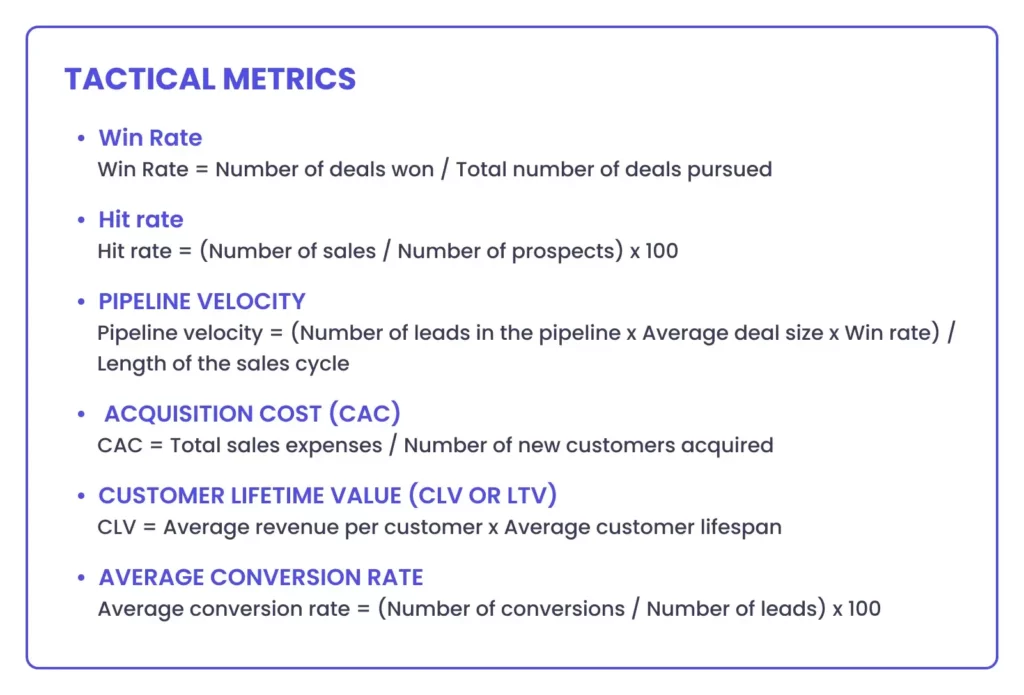
1. Win Rate
It is the most important metric to gauge the effectiveness of your sales strategies. It represents the percentage of deals you successfully closed out of the total deals over a period.
Win rate = Number of deals won / Total number of deals pursued
2. Hit Rate
The hit rate is the ratio of successful sales to the total attempts you made. It helps you determine how many prospects have converted to real paying customers.
Hit rate = (Number of sales / Number of prospects) x 100
3. Pipeline Velocity
This metric helps you measure the speed at which prospects move through your sales pipeline. It helps you identify bottlenecks and areas of improvement to boost efficiency.
Pipeline velocity = (Number of leads in the pipeline x Average deal size x Win rate) / Length of the sales cycle
4. Customer Acquisition Cost (CAC)
The customer lifetime value represents how much a customer is worth to your company throughout their association. It is the total value they bring to the table through repeat purchases, upsells, and cross-sells.
CLV = Average revenue per customer x Average customer lifespan
5. Customer Lifetime Value (CLV or LTV)
The customer lifetime value represents how much a customer is worth to your company throughout their association. It is the total value they bring to the table through repeat purchases, upsells, and cross-sells.
CLV = Average revenue per customer x Average customer lifespan
6. Average Conversion Rate
The average conversion rate gives you the percentage of leads that successfully convert into customers. It helps you measure the effectiveness of your sales process. The higher the rate, the better your performance.
Average conversion rate = (Number of conversions / Number of leads) x 100
Operational Metrics
Operational metrics provide a broader view of your overall sales performance, allowing you to evaluate the efficiency and effectiveness of your sales team and processes. Here are 4 operational metrics that you must track:
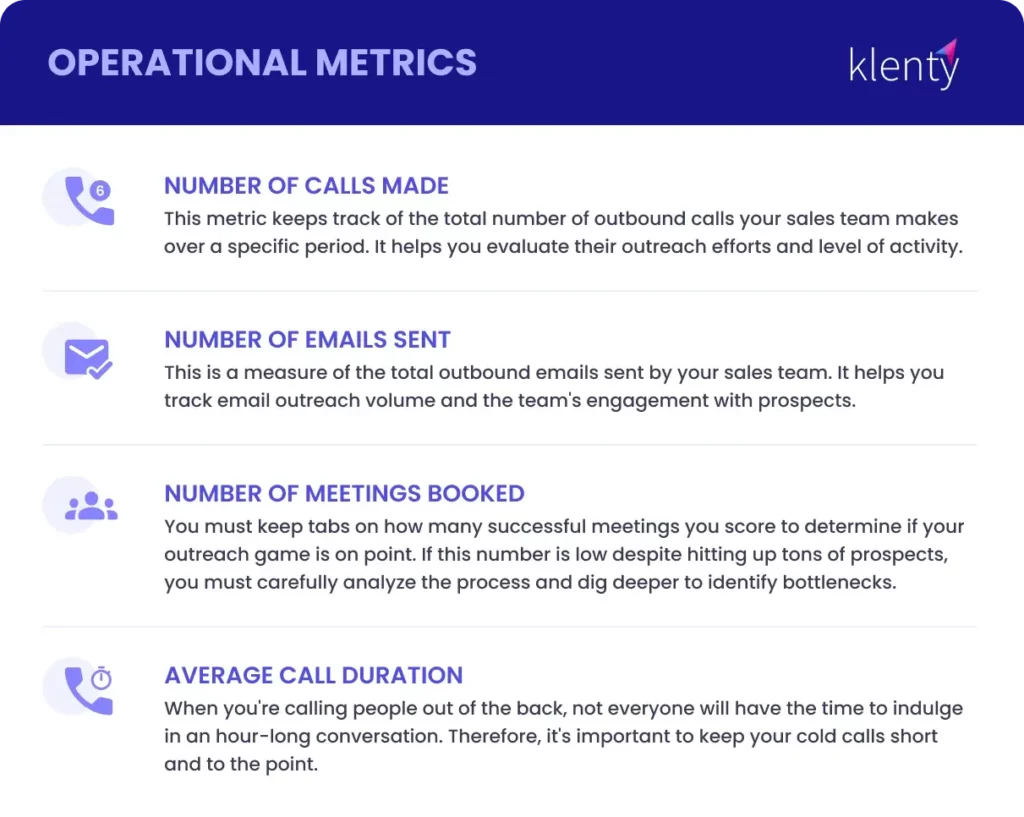
7. Number of Calls Made
This metric keeps track of how many cold calls your sales reps make over a specific period. It helps you evaluate their outreach efforts and level of activity. The number of calls you make depends on how targeted your pipeline is.
8. Number of Emails Sent
This measures how many cold emails your reps send. It helps you track email outreach volume and the team's prospect engagement. It also helps you track the email formats with the highest open and response rates.
9. Number of Meetings Booked
You must keep tabs on how many successful meetings you score to determine if your outreach game is on point. If this number is low despite hitting up tons of prospects, you must carefully analyze the process and dig deeper to identify bottlenecks.
10. Average Call Duration
When you're calling people out of the back, not everyone will have the time to indulge in an hour-long conversation. Therefore, it's important to keep your cold calls short and to the point. On average, a cold call lasts 1 minute and 20 seconds.
Take Your Outbound Sales to the Next Level
The key to nailing your outbound sales game is having the right tools. If you are looking for a sales engagement tool to streamline your outbound sales efforts and drive consistent outreach, look no further than Klenty.
Klenty automates follow-ups, ensuring no prospect falls through the cracks. Plus, you can reach out to leads through multiple channels, personalize each interaction, and adapt your outreach to match your prospect’s buyer journey. Check out Klenty’s features to see how it can take your outbound sales to the next level.
FAQs
1. What is the difference between inbound and outbound sales?
2. What is outbound sales in simple words?
3. Which is better: outbound or inbound?
4. How do you make a good outbound sales call?
- Start by researching your prospect and understanding their goals and pain points.
- Prepare a script, personalize your message, and focus on solving their issues.
- Listen actively and ask relevant questions to engage the prospect in a meaningful conversation.
- Explain how exactly your product will make their work easier.
